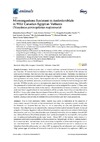Please use this identifier to cite or link to this item:
https://accedacris.ulpgc.es/jspui/handle/10553/74666
| Title: | Microorganisms Resistant to Antimicrobials in Wild Canarian Egyptian Vultures (Neophron percnopterus majorensis) | Authors: | Suárez Pérez, Alejandro Corbera Sánchez, Juan Alberto González Martín, Margarita Rosa Donázar, José Antonio Rosales Santana, Rubén Sebastián Morales, M. Tejedor Junco, María Teresa |
UNESCO Clasification: | 241401 Antibióticos 3105 Peces y fauna silvestre |
Keywords: | Antimicrobials Antibiotic resistance Escherichia coli Salmonella Canarian Egyptian vulture, et al |
Issue Date: | 2020 | Project: | Presencia de Patógenos en la Población de Animales Juveniles de Guirre (Neoprhon Percnopterus Majorensis) en la Isla de Fuerteventura y Lanzarote. | Journal: | Animals | Abstract: | Due to their predatory habits, raptors may serve as indicators of the presence of antimicrobial-resistant bacteria in the environment, but they also represent a public health risk for livestock and humans because they can act as reservoirs, sources and spreaders of these bacteria. Our objective was to determine the presence of antimicrobial-resistant bacteria in cloacal samples of Canarian Egyptian vultures (Neophron percnopterus majorensis), an endemic bird of prey. One hundred and forty-two cloacal swabs were obtained; Escherichia coli was isolated from 80.28% and Salmonella from 6.3% of these samples. Low levels of susceptibility to ampicillin, tetracycline and trimethoprim/sulfamethoxazole were found. About 20% of the isolates were resistant or presented intermediate susceptibility to fluoroquinolones. Surprisingly, we found isolates resistant to imipenem (6.96%). Isolates from chicks were more susceptible to antimicrobial drugs than adult and immature birds. About 50% of E. coli isolates were resistant to ampicillin, tetracycline and trimethoprim/sulfamethoxazole, and about 20% to piperacillin, enrofloxacin and marbofloxacin. High percentages of isolates of Salmonella were found to be resistant to cephalexin (88%) and aminoglycosides (greater than 77%). Our results support the idea that raptors could act as reservoirs of Salmonella and antimicrobial-resistant bacteria, posing a risk not only to wildlife but also to livestock and the human population, thus reinforcing the need to minimize the exposure of wildlife to antimicrobial agent through human and livestock waste. | URI: | https://accedacris.ulpgc.es/handle/10553/74666 | ISSN: | 2076-2615 | DOI: | 10.3390/ani10060970 | Source: | Animals [ISSN 2076-2615], v. 10 (6), 970 |
| Appears in Collections: | Artículos |
WEB OF SCIENCETM
Citations
9
checked on Jun 8, 2025
Page view(s)
162
checked on Aug 10, 2024
Download(s)
118
checked on Aug 10, 2024
Google ScholarTM
Check
Altmetric
Share
Export metadata
Items in accedaCRIS are protected by copyright, with all rights reserved, unless otherwise indicated.
